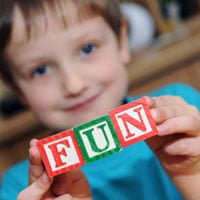60-day returns • free shipping on USA orders $129+


Last week we talked about how to introduce the alphabet to your child through fun, informal play activities. Once your child knows his alphabet and the sounds the letters make, you can begin to put those sounds together to make short words. Two things to keep in mind at this stage. First, remember to keep these activities informal, and second, focus on words that mean something to your child.
Think about the way your child learned to understand the spoken word. He saw the ball, for example, and heard the sound-sign that represents it, “ball.” Pretty soon his little brain automatically associated the object with its sound-sign. Use the same strategy for this pre-reading stage. Introduce the word-signs that go with familiar objects and your child will find it easier to learn them. Here’s how.
The Pre-school/Kindergarten Stage: Word-Building Activities
Take two of your child’s letter blocks and make the word “at.” Explain that it is the word we use when we say “at home” or “at the store.” Then one by one put a different consonant at the beginning to form a new word: bat, cat, fat, hat, mat, sat, rat, etc. Help your child say each new initial sound and word as you form it with the letters. “What do we have if we put b at the beginning? c at the beginning?”
After your child finds this step easy, switch it around and have him find the correct initial letter for each word as you say it aloud. Now, don’t think you will be doing all of this in one long lesson. Remember, keep these activities informal and very short. Spread them out over time so your child’s brain has plenty of opportunity to ruminate and absorb these new concepts.
Pretty soon your child will be able to do the “lesson” all by himself. All you’ll need to say is, “How many words can you make with ‘at’ and another letter?”
Once he has the “at” combination figured out, move on to other combinations like “en” or “od.” Take your time and keep it light.
Now for Long Vowels
When the three-letter word activities are no longer challenging or interesting to your child, introduce a new twist: long vowels. Show how you can add an e to the end of “at” to make “ate,” then “late,” “rate,” etc. You can informally explain that the a in “rat” is short a and the a in “rate” is long a. Repeat the activity with other letter combinations, making them long vowel words.
You’re almost ready to begin real reading lessons. First, you need to introduce one more concept.
And Finally, Blends
Follow the same word-building process with a couple of common blends: ng and th. Make words with the combinations “ing,” “ang,” “ong,” and “ung”; such as “ring,” “fang,” “long,” “sung.” Then introduce words with th at the beginning, words like “then” and “that.” And finally, words with th at the end, such as “with,” and with any other blend combinations you want to introduce.
By this time your child will be able to recognize several dozen words.
This is not reading, but it is preparing the ground for reading; words will be no longer unfamiliar, perplexing objects, when the child meets with them in a line of print (Home Education, p. 203).
Now comes the fun part: making the transition from reading some isolated words to reading lines of text in a book. That’s where Charlotte’s reading lessons shine. Next week we will explain how.

How many word families per short vowel should we work on at this stage? One or two or something like that?
Good question, Karen. The only combinations that Charlotte specifically mentioned were at, en, and od. But she was giving examples, not a complete listing. The closest I can find to a complete listing is this quote:
Now, that being said, don’t feel like you have to cover every possible combination of vowel and consonant. Word-building will continue in the reading lessons, and you will have opportunity to cover many combinations at that point. (We will describe the reading lessons in parts 3 and 4 of this series.) This stage of the process is more to get him comfortable with the concepts of word-building, vowel sounds, and some blends, as well as to give him a good storehouse of dozens of words that he can recognize as old friends when he sees a line of text.
Remember that this stage can last many months, so there’s no need to hurry.
We’re not even close to this stage yet with my daughter, but one thing that I got when I was teaching my baby brother to read was a phonics bible. It’s a children’s bible and each bible story within it focuses on a single sound. That sound is then printed in red throughout the story so that as you read the bible, the child can begin to see the sounds as you go. My baby brother was public schooled, so all I actually did was start him off, but he made a lot of progress just over one summer. And all I did was read to him from that bible and we worked through one of the Explode the Code books.
I just finished a different reading book with my 5 year old. I would like to try this method with my 3.5 year old (when he is ready) and compare the two.